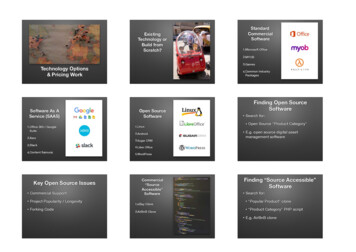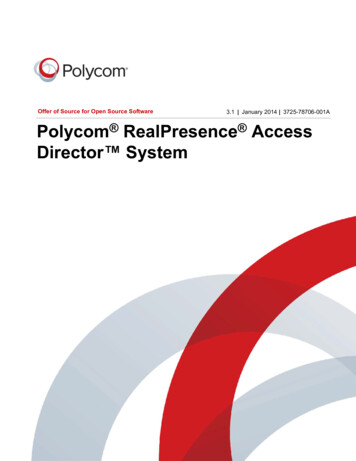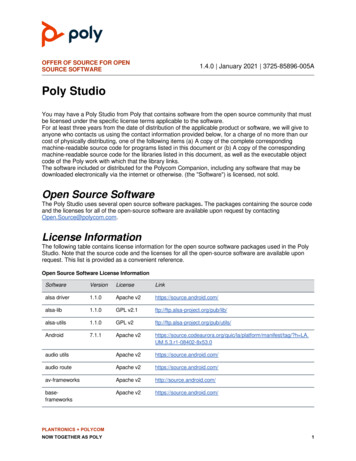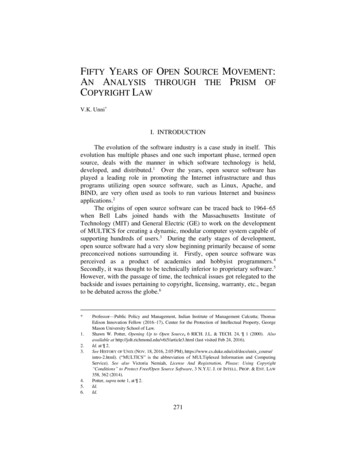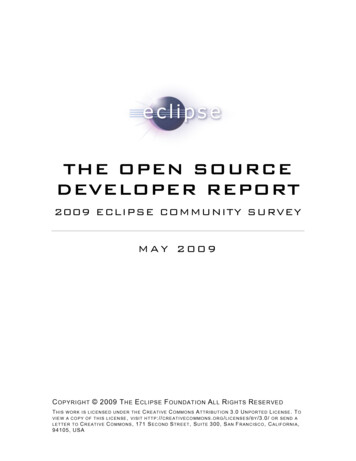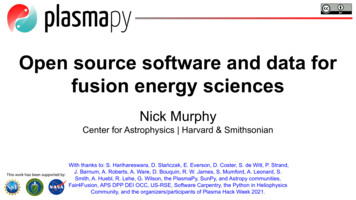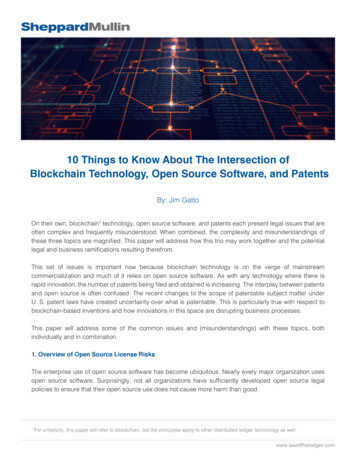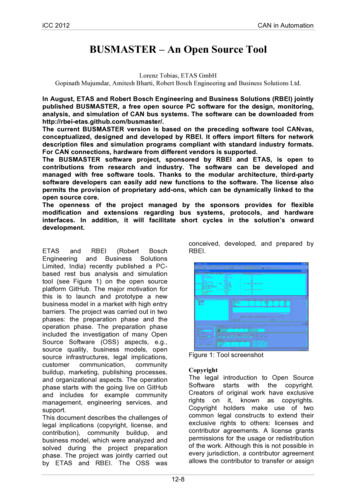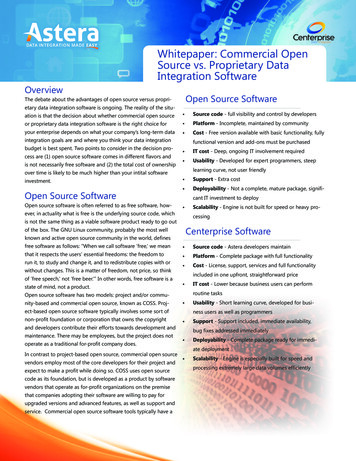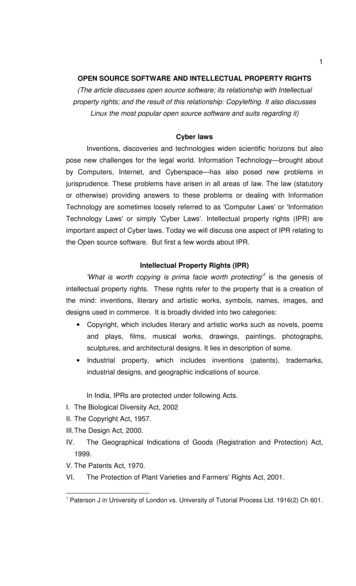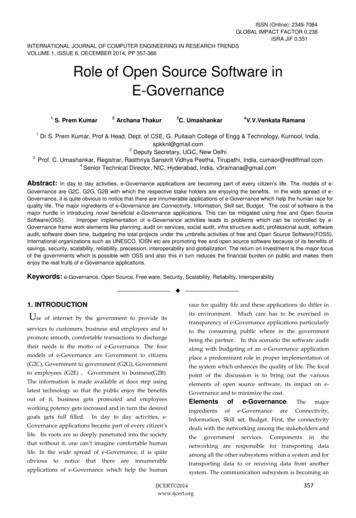
Transcription
ISSN (Online): 2349-7084GLOBAL IMPACT FACTOR 0.238ISRA JIF 0.351INTERNATIONAL JOURNAL OF COMPUTER ENGINEERING IN RESEARCH TRENDSVOLUME 1, ISSUE 6, DECEMBER 2014, PP 357-366Role of Open Source Software inE-Governance1S. Prem Kumar2Archana Thakur34C. UmashankarV.V.Venkata Ramana13Dr S. Prem Kumar, Prof & Head, Dept. of CSE, G. Pullaiah College of Engg & Technology, Kurnool, India,spkknl@gmail.com2Deputy Secretary, UGC, New DelhiProf. C. Umashankar, Registrar, Rasthriya Sanskrit Vidhya Peetha, Tirupathi, India, cumaor@rediffmail.com4Senior Technical Director, NIC, Hyderabad, India, v3ramana@gmail.comAbstract:In day to day activities, e-Governance applications are becoming part of every citizen’s life. The models of eGovernance are G2C, G2G, G2B with which the respective stake holders are enjoying the benefits. In the wide spread of eGovernance, it is quite obvious to notice that there are innumerable applications of e-Governance which help the human race forquality life. The major ingredients of e-Governance are Connectivity, Information, Skill set, Budget. The cost of software is themajor hurdle in introducing novel beneficial e-Governance applications. This can be mitigated using free and Open SourceSoftware(OSS).Improper implementation of e-Governance activities leads to problems which can be controlled by eGovernance frame work elements like planning, audit on services, social audit, infra structure audit, professional audit, softwareaudit, software down time, budgeting the total projects under the umbrella activities of free and Open Source Software(FOSS).International organizations such as UNESCO, IOSN etc are promoting free and open source software because of its benefits ofsavings, security, scalability, reliability, precession, interoperability and globalization. The return on investment is the major focusof the governments which is possible with OSS and also this in turn reduces the financial burden on public and makes themenjoy the real fruits of e-Governance applications.Keywords: e-Governance, Open Source, Free ware, Security, Scalability, Reliability, Interoperability—————————— ——————————1. INTRODUCTIONUserace for quality life and these applications do differ inof internet by the government to provide itsits environment.Much care has to be exercised intransparency of e-Governance applications particularlyservices to customers, business and employees and toto the consuming public where in the governmentpromote smooth, comfortable transactions to dischargebeing the partner.their needs is the motto of e-Governance. The fouralong with budgeting of an e-Governance applicationmodels of e-Governance are Government to citizensplace a predominant role in proper implementation of(G2C), Government to government (G2G), Governmentthe system which enhances the quality of life. The focalto employees (G2E) , Government to business(G2B).point of the discussion is to bring out the variousThe information is made available at door step usingelements of open source software, its impact on e-latest technology so that the public enjoy the benefitsGovernance and to minimize the cost.out of it, business gets promoted and employeesElementsworking potency gets increased and in turn the desiredingredientsgoals gets full filled.In day to day activities, e-Information, Skill set, Budget. First, the connectivityGovernance applications became part of every citizen’sdeals with the networking among the stakeholders andlife. Its roots are so deeply penetrated into the societythethat without it, one can’t imagine comfortable humannetworking are responsible for transporting datalife. In the wide spread of e-Governance, it is quiteamong all the other subsystems within a system and forobviousinnumerabletransporting data to or receiving data from anotherapplications of e-Governance which help the humansystem. The communication subsystem is becoming antonoticethatthereareIJCERT 2014www.ijcert.orgofofgovernmentIn this scenario the software Connectivity,Componentsin357the
ISSN (Online): 2349-7084GLOBAL IMPACT FACTOR 0.238ISRA JIF 0.351INTERNATIONAL JOURNAL OF COMPUTER ENGINEERING IN RESEARCH TRENDSVOLUME 1, ISSUE 6, DECEMBER 2014, PP 357-366increasingly important component of e-Governancesector of the economy based on its operation.systems.estimation of expenditure and comparison of the costsThe communication subsystem can besubjected to passive or active subversive attacks. Oneversus theway to reduce expected losses in the communicationestablished. The estimation of expenditure differs fromsubsystem is to choose physical components that haveone application to another application because of thecharacteristics which make them reliable and thatdiffering installed bases, capital replacement costs andincorporate features or provide controls which mitigatespending requirements on infrastructures for e-theVariousGovernment readiness. As e-Governance is an onlineareactivity, the cost incurred for privacy and securitycommunication control lines, modems, port protectionshould also be considered and to be minimized.devices,errorDifferent funding methods in practice are issuingdetection and correction circuits, flow controls, linkbonds, inventive financing methods like outsourcing,controls, topological controls, poling methods, Internetsoftware leasing, rent to own ls etc. Most of the communication protocols arebenefitsofe-Governmentis toThebeOpen Source Software: The source code of thedeveloped using Open Source Software.software is kept visible and open to perform anySecond, the information which is to be shared tomodifications to it and redistribute it is the concept ofstakeholders should be complete, perfect, latest andopen source software. Free open source software as ashould be well organized and accessed from data basespolitical idea and as a movement came into force withusing data mining techniques and even today thethe founding by Richard Stallman of the Free Softwareconcepts of big data are gaining it’s strength withFoundation and its GNU/Linux Project in 1984. Thesuitable application software. Considerable databasename GNU was chosen following a hacker tradition, gcontrols,a recursive acronym for ‚GNU’s Not Unix‛.Controls,benefits of OSS are huge which includes Cost savings,Controls,Security, Reliability, Open standards, avoidance ofTheaccounting audit trails, Operations Audit Trail, backvendorup, logging etc. The application software developedDeveloping local software industry, Localization, Zerousing OSS plays a predominate role in providing thelicensing costs, easier administration, especially withneedful information to clients.thin-clientThird, the Skill set required for smooth operations of e-patching. This introduced the concept of OpenGovernance in technical perspective plays vital role.government where e-Governance process, perform andThe operations management is responsible for the dailycommunity software plays a critical role in informationrunning of hardware and software facilities so that e-management. In this decade, the Open source softwareGovernance application systems can accomplish theirrevolutionized various fields of public services and thework and the development staff can design, implementinternational organization like UNESCO, IFLA, IOSNand maintain application systems systematically.promotedOperations management typically exercises controlsmanagement, digital library and integrated libraryover Computer operations, Communications networkmanagement fields. The implementation of OSS in e-control, Data preparation and entry, ProductionGovernance applications is gradually gaining itscontrol, File library, Documentation and tycontentlibrary, Help desk/technical support, Capacity planningand performance monitoring, Outsourced operations.Finally the budgeting plays a pivotal role in promotinge-Governance activities. India being a lementation of e-Governance. The Capital can be onpublic or private partnership. It refers to money usedby government to provide their services or to thatIJCERT 2014www.ijcert.org358
ISSN (Online): 2349-7084GLOBAL IMPACT FACTOR 0.238ISRA JIF 0.351INTERNATIONAL JOURNAL OF COMPUTER ENGINEERING IN RESEARCH TRENDSVOLUME 1, ISSUE 6, DECEMBER 2014, PP 357-366OSS Vs Proprietary: Open source software is basedaround the idea that the user can not only view, butchange the source code of an application. Closed sourcesoftware is hidden to prevent the user either viewing orchanging the code. After initial production, open sourcesoftware is released to the development community andundergoes a secondary phase of evolution. It isscrutinized by thousands of professional developersacross the globe that highlights potential flaws, bugs andsecurity glitches. Closed source software is developed inisolation with a small team of developers. It isn't possibleto build a team of hundreds to check the code becauseFig 1. Technology Architecturethe code is deemed proprietary and secret. The workingmodel of OSS in relevance with e-Governance is asIn India, knowledge commission under chairmanshipfollows.of Sam Pitroda recommended open source software fore-governance and information management. In 2001UNESCO decided to get on this relatively newapproach of not only providing the software for freebut also making the source codes in principle ‘open’,i.e. publicly available on the website. This has finallylead to a framework of its wider ‘Free and Open SourcePortal’ approach promoting the idea and adding othersoftware. The Asia Pacific Development InformationProgramme (APDIP) is an initiative of the UnitedNations Development Programme (UNDP) that aims topromote the development and application of newInformation and Communication Technology (ICT).The International Open Source Network (IOSN) is aninitiative of APDIP and supported by the InternationalDevelopment Research Center of Canada. IOSN is acenter of excellence for free /open source software,Open content and open standard in the Asia Pacificregion. IFLA working group on Open Source Softwareinitiated direct activities of IFLA IT section inpromoting standards in open source and publishingopen source frameworks for libraries. Also workingwith other agencies actively engaged in open source toencourage regional support initiatives for open source.The National Knowledge Commission was set up bythe Prime Minister Dr. Manmohan Singh under thechairmanship of Sam Pitroda, to prepare a blueprint totap into the enormous reservoir of our knowledge baseso that our people can confidently face the challengesof the 21st century. The commission made varioususefulrecommendationsimplementation with OSS.onthee-GovernanceFig 2. The working model of OSS in relevance with eGovernanceFOSS in e-Governance: Free of cost available OpenSource Software is called as Free Open Source cilitates sharing, examination, reuse, modification andredistribution of various e-Governance applications withfaster development, time saving, low cost or zero cost,shares innovative ideas of one to other which aids an network, cost cut down to common public inproviding services, improved return on investment,leading to profits and prosperity. The benefits of FOSSare one can evaluate in detail, lowering risk, can see ifmeets needs (security, etc.), can perform mass peerreview typically greatly increases quality/security, aidslongevity of records, Government transparency, cancopy repeatedly at no additional charge, support mayIJCERT 2014www.ijcert.org359
ISSN (Online): 2349-7084GLOBAL IMPACT FACTOR 0.238ISRA JIF 0.351INTERNATIONAL JOURNAL OF COMPUTER ENGINEERING IN RESEARCH TRENDSVOLUME 1, ISSUE 6, DECEMBER 2014, PP 357-366have per-use charges, share development costs withother users and can control own destiny.Even thesoftwareimprovedFor many Governments the world over, the choice ofperformance of servers, services, database, utility anddowntimeisreducedwithOpen Source is a strategic one. The preference towardsother application programs. e-Government encouragesOpen Source platforms is firstly because, acquiring andadoption of e-Commerce,e-Business in governmentupgrading proprietary software is expensive. There isagency operations which can be promoted successfullyalso the proposition that it is safer to entrust knowledgewith high degree of security using OSS.in the public domain to Open Source, which is also in theFOSSauthorizes interested government employees, contractorspublic domain, than to proprietary platforms.Usingand citizens to offer help and capture their contributionsopen source would enable India to encourage our ownfor proposing and incorporating enhancements orsoftware professionals to provide software support in themodifications in the software which democratizes theform of add-on applications that could be written at acreation of public. This will codify the processes intocost much smaller than that required to buy multi-high level, user friendly process models. These featuresfeatured packaged software. Various open sourcemade OSS operating system, middle ware and databasesoftware products are shown in the table.in e-Governance to gain its strength day by day and isexpected to shoot up in near future.Fig 3. Expected growth of OSS from 1995 to 2015[Source:Red hat summit 2009]Software categoryFree & Open SourcePurposeOperating systemLinuxDesktop & server operating systemWeb developmentApache web server, page HostingOffice productivityandtool , php, DrupaldevelopmentOpen s,WebWordprocessingImage processingGIMPImage processingInternet accessMozillaWeb browsingEmailPine, Send mail , KmailFor email serviceAudio / visual playerHelix , ogg VorbisAudio / visual playersAnti – virusClam , ClamWinWorms and Trojans detection and cleaningDatabase management systemsMysqlDatabase development and managementIJCERT 2014www.ijcert.org360
ISSN (Online): 2349-7084GLOBAL IMPACT FACTOR 0.238ISRA JIF 0.351INTERNATIONAL JOURNAL OF COMPUTER ENGINEERING IN RESEARCH TRENDSVOLUME 1, ISSUE 6, DECEMBER 2014, PP 357-366The scope of global participation in incorporating theBusiness (G2B) issues and Government to Governmentsuggestions in the form of code, transparency in military(G2G) issues. To mitigate the issues the following frameand security applications is added benefit of FOSS. Thework activities are proposed under umbrella of free androle of FOSS is vital in e-Governance framework and isOpen Source Software.discussed below.e-GovernanceFramework:Issuesofe-Governance can be classified under three headsGovernment to Citizen (G2C) issues, Government toFramework Activities: The e-governance frameworkAudit on Services: An e-Government service iscomponents are planning, audit on services, social audit,defined as an application, or series of applications, on theinfra structure audit, professional audit, software audit,internet that provides a specific service to a citizen orsoftware down time, budgeting the total projects.business. The applications are interactive and transactionPlanning: Determining the goals, functions of the e-based. The goal of an e-Service is to provide a start-to-Governance and the means of achieving these is done infinish solution to the customer. Coverage of Criticalplanningactivitycitizen services is the prime criteria for selection of an e-commences with planning phase and it is followed byphase.Governance project for audit. Evaluation of Quality ofdifferentandservice with end user satisfaction is the scale forControlling. In the planning phase itself pave the waymeasuring performance of e-Governance projects. Thewith OSS or FOSS for the proposed applications. Thepeek standards of quality can be achieved with servicesmerits and demerits of OSS and proprietary software isprovided by FOSS.phasesto be ial Audit: e-Governance is the process designedfor public benefit.IJCERT 2014www.ijcert.orgHence while designing the e-361
ISSN (Online): 2349-7084GLOBAL IMPACT FACTOR 0.238ISRA JIF 0.351INTERNATIONAL JOURNAL OF COMPUTER ENGINEERING IN RESEARCH TRENDSVOLUME 1, ISSUE 6, DECEMBER 2014, PP 357-366Governance applications, it the responsibility ofpermits sharing and resources within a computergovernment to make people participate in its designsystem are audited.and implementation.A social audit is a process inDown Time Audit: Performance audit reportswhich the people work with the government toconcern the efficiency, effectiveness, economy of amonitor and evaluate the planning and implementationparticular government activity.of a scheme or program, or indeed of a policy or law.directlyInfrastructure Audit: e-Governance projects withapplication.transparency and decreasing corruption is catching eyeperformance is the citizen satisfaction in terms ofof public. The infrastructure includes all the physicalconvenience, increased transparency and protection ofandabstractdevelopingelementsandrelatedtoTheThe performance areinvolvedinthe confidentiality, integrity and the reliability of theimplementingthee-Governanceinformation stored and processed by the e-Governanceapplications using FOSS. As multiple elements areFOSS applications.involved in the development of e-Government projects,Budgeting: The estimation of expenditure andthe infrastructure is habitually the element most opencomparison of the costs versus the benefits of e-to compromise and this is the one that frequentlyGovernment is to be established.presents the greatest risk to e-Government projects.expenditure differs from one application to anotherProfessional Audit: Professional audit is one ofapplication because of the differing installed bases,the key points in e-Governance framework. As per thiscapital replacement costs and spending requirementsthe skills of various IT professional are audited to seeon infrastructures for e-Government readiness. As e-whether they have in depth knowledge in FOSSGovernance is an online activity, the cost incurred forsoftware, they obey certain standards to fit into theprivacy and security should also be considered. Thework to produce quality E-Governance applications.cost cut down can be down drastically using FOSSAs most of the e-Governance applications are online,software.and many of the citizens, organizations and othersStandards: A standard is defined as a technicalinteract with these applications, the professionals whospecification or other document available to the public,develop these applications should possess certaindrawn up with the cooperation and consensus orqualities to receive the appreciations.general approval of all interests affected by it, based onSoftware Audit: The software which is used for thethe consolidated results of science, technology ande-Governance applications should be audited forexperience, aimed at the promotion of optimumcorrectness, perfectness, scalability and availabilitycommunitywhich are available to precession in FOSS. The softwarerecognized at the national, regional or internationalaudit comprises Application software audit, Databaselevel.audit and System software audit.benefitsandThe estimation ofapprovedbyabodyIn ApplicationQuality of software is the major considerable factor insoftware audit, programs which are developed for e-e-Governance activities. The quality is maintained byGovernance applications, the purchased programs,following certain global standards which play annetwork protocols, the related packages and utilitiesimportant role in building the architecture of e-are to be audited by auditors. In Database audit, theGovernance involving free or Open Source Software.data which is acquired through application programsMyths & Realities of OSS:are stored in database and audited. In System softwaremisconceptions in public on OSS and the realities areaudit, the operating system, firmware, hardware thatpresented below.Myths on OSSThere are someRealityOpen source is a niche Perhaps this was a fair comment when Linux and Apache were in their infancy, but nowIT sectoropen source has established a firm foothold in the data centre, and this statement could notbe further from the truth.Open source cannot Many opponents to open source fuel the idea that open source is not reliable enough to runsupportmission- mission-critical applications, and that the quality of open-source products is poor. YetIJCERT 2014www.ijcert.org362
ISSN (Online): 2349-7084GLOBAL IMPACT FACTOR 0.238ISRA JIF 0.351INTERNATIONAL JOURNAL OF COMPUTER ENGINEERING IN RESEARCH TRENDSVOLUME 1, ISSUE 6, DECEMBER 2014, PP 357-366critical applicationsopen-source products are subjected to the same levels of performance, stress, functional,security and regression tests that closed source products are. In addition, an advantage ofthe open source development model is that it enables collaboration with the end-user veryearly in the development cycle, allowing bugs and design flaws to be identified early.Opensource This is a misconception. The truth is that open source software is subject to the samecompanies do not own copyright laws as closed-source software, but open source software suppliers choose totheirintellectual share their IP with others. So, products are brought to market faster, open source softwarepropertycannot be monopolized, no one organization can control the price for support and servicesfor open source solutions, and the competition to provide support services at an attractiveprice-point makes it more cost-effective for customers. We think it is time now to call thebluff on closed-source vendors.Opensource Today, open source providers offer professional support, and make it possible for thetechnology does not software to run mission-critical applications for major, global companies. Indeed, theoffer professional level business model for most open source software providers depends on customers buyingsupport and services.supportOpensourceunregulatedis Some opponents of open source propagate the myth that anyone can access and changeand open-source code, which makes it unsecured and unreliable. However, the truth is thatanyone can contribute access to open source code is controlled, and any changes to the source must either addresscodea problem, or enhance the product.Open Source software A common misunderstanding is that open source software is more vulnerable tois not secureexploitation than closed-source software, simply because code that is exposed is morelikely to be hacked. Open source software is secure by design and uses standard softwaredevelopment methodologies and secure coding techniques. All source code changes aresubjected to rigorous peer review before acceptance. Because of this review, more proactivechecking for vulnerabilities occurs, bringing to light any exploits in the code, andproviding built-in security from the ground up.Cost cut down: It is noticed from the past five yearsfor50403020100e-Governanceapplications and the budget allotments could not reachthe expectations because of financial constraints. In thisregard the governments of various countries areseriously focusing on the pivotal element of budgetIT-Budget1 yearallotment to e-Governance to cut down the cost and theeGov.Applicationsultimate choice is FOSS.5 yeardemand4 yearincreasing3 yearis2 yearthereFig 5. Growing importance of e-Gov Applications andBudget allotmentsIJCERT 2014www.ijcert.org363
ISSN (Online): 2349-7084GLOBAL IMPACT FACTOR 0.238ISRA JIF 0.351INTERNATIONAL JOURNAL OF COMPUTER ENGINEERING IN RESEARCH TRENDSVOLUME 1, ISSUE 6, DECEMBER 2014, PP 357-366It is estimated that the licensing cost per system, pertheir support for older versions once a new version oryear on average is Rs.15300 which includes licensingproduct is released and this indirectly pressurizes thecost of operating system, application software, datauser to purchase the new product which involves hugebase and cost of various system utilities, excluding thecost. The load on government to invest for e-hardware maintenance cost. The pricing of the popularGovernment is one side of the coin and on the otheroperating system like windows, application softwareside it burdens common man in terms of servicelike visual studio.net, Microsoft Office, back endcharges. The only solution for this is FOSS, where thedatabase like oracle and various antivirus utilities liketotal software cost can be enormously reduced whichAvast, K7 etc is high and causing inconvenience to theleads to savings and profits. Linux for e-governancestack holders.benefits both government operations and the citizensThe expenditure for a 1000 seatedorganization goes upto Rs.1.5 crores only on e,operational,capital, marketing, ads and other overheads.FOSScan beobtained freeof rovidinginteroperability,providing a robust and stable system to supportwhere er charges for the delivery. One pays for thesimplifying system maintenance and management.sharing or network connectivity cost of download.Regarding Licensing GNU opts for ‚General PublicApart from that no loyalty or licence fees apply andLicense‛ (GPL), that is no standard open source license,one copy is enough for unlimited installations andbut GPL is most widely used (roughly 85% of opendistribution. The options are using Ubuntu or Linuxsource software). The terms include, User freedom towhich cost max of Rs.50 paying for download,distribute and/or modify, Requirement that originaloperations cost. If the proprietary software Microsoftand modified source code be always made available toWindows.8 is purchased it costs around Rs.3000 andthe world under the terms of the original license, Mustcan be noticed a drastic savings of Rs.2950 on oneretain copyright notices and warranty disclaimers, doesinstallation and that too on operating system.not include grant of patent licenses.Inaddition a system needs an application software,OSS Global revolution: USA formed a task forcedatabase, utilities which are provided as bundle byto identify and implement priority actions that achieveFOSS and the most popular LAMP Linux operatingstrategic improvements in government and set insystem, Apache server, MySql database, PHP webmotion a transformation of government around citizentechnologies comes in this category.Higher end i7needs using Open Source Software. In the recent pastprocessor system with latest specifications coststhe governments of United Kingdom came out with aRs.70000ofdocument ‚e-Government: A Strategic Framework forproprietary software with latest versions which againPublic Services in the Information Age‛ and introducedinvolves cost.various projects using OSS. In December, 2013, theprocessorsapproximatelyneedsthechangeThe FOSS can efficiently run on oldhardwareItalian government issued final rules implementing acomponents with a minimum expenditure of Rs.5000.change to procurement law that now requires all publicThis makes FOSS more cost saving option opposed toadministrations in the country to first consider re-usedproprietary solutions. The new release of proprietaryor free software before committing to proprietaryoperating system operating systems means morelicenses. Free Software Foundation Europe offers aprocessingisgood explanation of the changes in its press release.demanded than the previous version. SpecificationsNew Zealand Government came out with its e-required for Windows XP need to be doubled for anGovernment vision document ‘E-Government Unit’efficient Windows 2008 ultimate installation. Thiswas established by the State Services commission.means continuous costly hardware upgrades for e-South Africa, realized the cost benefits of FOSS and thegovernance systems set up on proprietary softwaredevelopmentwhich increases investment and hampers the returns.communication technology skills. Key strategies inThewithsupport of open source have included governmentproprietary software is the support team reduce or stopprocurement policies that favor open source ,shadeandtoofstoragebespacenoticedIJCERT 2014www.ijcert.orgofalocalinformation364and
ISSN (Online): 2349-7084GLOBAL IMPACT FACTOR 0.238ISRA JIF 0.351INTERNATIONAL JOURNAL OF COMPUTER ENGINEERING IN RESEARCH TRENDSVOLUME 1, ISSUE 6, DECEMBER 2014, PP 357-366for government services such as schools, hospitals,public works etc.In South Africa, the governmentCONCLUSION:approved the proposal that when proprietary and openInternational organizations such as UNESCO, IOSN etcsource are equal, open source will be given preferenceare promoting free and open source software. Becauseowingimproved returns on investmentof the colossal size and scope of the e-Governanceassociated with the elimination of licensing and theeffort in India and because of the availability ofendless maintenance agreements that lock governmentglobally recognized software talent of Indians, oneinto expensive long-term contracts. In Nigeria, an SMSmustHelpdesk Application developed with open source is inimplementationsuse to provide helpdesk functionality to citizens inpossible. This will allow having cost-effective solutionsLagos. In India, Delixus, Inc., a private IT company,and helping with standards. The governments shouldimplemented, the Delixus e-Governance platform thatserveenhanced the features of Linux to provide improvedapplications and also should target to generate revenueser
Open Source Software: visible and open to perform any modifications to it and redistribute it is the concept of open source software. Free open source software as a political idea and as a movement came into force with the founding by Richard Stallman of the Free Software ation and its GNU/Linux Project in 1984. The

